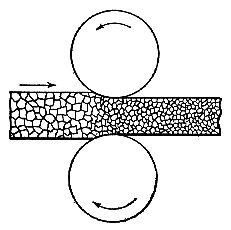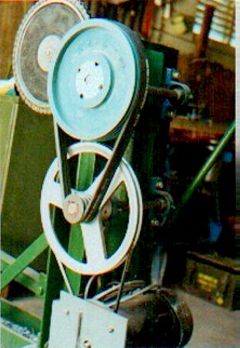
|
Hugh McDonald
Steel Rolling Mill Plans Examples and Additions to the Review
Building your own and about rolling steel
|
|
Review Part II - by Jock Dempsey Part I - Review
CD-ROM review and example
DO NOT under estimate the thought and engineering that went into this machine. I have spent a lot of time discussing this machine with Hugh McDonald and Jim Steele via e-mail and post and a lot of thought and R&D has gone into making this a successful machine. As an experienced machine designer and builder I want to build my own and do it my way and I will. . . eventually. However, after a LOT of study and redesign there are few changes I would make in this machine. I DO have some improvements, but details about those will have to wait until I build it and try them out. |
|
- Jim Steele, WA, Australia | |

|

|
| Photos of the machine built for Jim Steele. Note the handwheel adjustment and roller details. These are carefully covered in the plans with excellent detailed drawings. | |

|

|
|
The drive train on these machines reduce the final output speed to 20 - 25 RPM which feeds the steel at about 14 feet per minute.
This large amount of reduction produces a HUGE amount of torque (force at shaft).
The drive train starts with a single belt drive, goes to a double belt drive and then finishes with a chain drive.
Each of these changes is needed to transmit the ever increasing torque as the speed slows down.
At 25 RPM with a 1 HP motor the final torque is ~2250 inch pounds. This means with a 2.125" diameter roller the mill has 2000 pounds of "push" on the steel (limited by friction). There is a lot of room for changes and adaptations of available (scrap?) parts in the drive train. However, you need to understand drive ratios and be able to do the simple calculations required. Hugh makes recommendations in the plans and explains many of these details (but you still have to do the math if you deviate from the plans). Jim Steele says that the the primary belt needs to be correctly sized so that if the machine is stalled (and you WILL stall it often when learning to use it) the belt will slip preventing damage to machine and motor. The horsepower needed is proportionate to the diameter of the rollers used. What this ratio is, or if it is a direct proportion, we have not determined. However, Hugh says his prototype machine only had a 1/2 HP motor and his plans recommend a 3/4 HP motor. The machine Kayne and Son builds has a 1HP motor and I suspect that other commercial machines will follow suit. | |

Forged work by Hugh McDonald, photo by Hugh McDonald Besides being one heck of an inventor Hugh is also a productive blacksmith. He says, "I figured an Australian Blacksmith should be able to make a Kangaroo head, so I worked on it till I got it fairly right." "The heads are made entirely on the front and back edges of the anvil from 25 x 6mm flat bar (~1/4 x 1" bar)."The blades on the letter openers are drawn out on the rolling mill. Hugh says, "Its the only way". Hugh originally wanted to draw out the reins on tongs using his rolled mill and he has. But now he makes them (a lot of them) another way. But THAT is the subject for another story. . . |
|
Hugh McDonald 150 Williams Rd. Gooseberry Hill 6076 Western Australia
| ||
|

